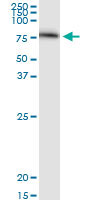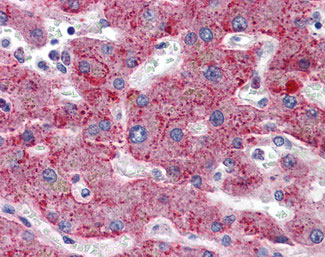SERPING1 / C1 Inhibitor Antibody (clone 3F4-1D9)
Mouse Monoclonal Antibody
- SPECIFICATION
- CITATIONS
- PROTOCOLS
- BACKGROUND

Application
| WB, IHC-P, E, IP |
|---|---|
| Primary Accession | P05155 |
| Reactivity | Human |
| Host | Mouse |
| Clonality | Monoclonal |
| Clone Names | 3F4-1D9 |
| Calculated MW | 55kDa |
| Dilution | IHC-P (5 µg/ml), WB (1:500-1:1000), |
| Gene ID | 710 |
|---|---|
| Other Names | Plasma protease C1 inhibitor, C1 Inh, C1Inh, C1 esterase inhibitor, C1-inhibiting factor, Serpin G1, SERPING1, C1IN, C1NH |
| Target/Specificity | Human SERPING1 |
| Reconstitution & Storage | Aliquot and store at -20°C or -80°C. Avoid freeze-thaw cycles. |
| Precautions | SERPING1 / C1 Inhibitor Antibody (clone 3F4-1D9) is for research use only and not for use in diagnostic or therapeutic procedures. |
| Name | SERPING1 |
|---|---|
| Synonyms | C1IN, C1NH |
| Function | Serine protease inhibitor, which acrs as a regulator of the classical complement pathway (PubMed:10946292, PubMed:11527969, PubMed:3458172, PubMed:6416294). Forms a proteolytically inactive stoichiometric complex with the C1r or C1s proteases (PubMed:10946292, PubMed:3458172, PubMed:6416294). May also regulate blood coagulation, fibrinolysis and the generation of kinins (PubMed:8495195). Very efficient inhibitor of FXIIa. Inhibits chymotrypsin and kallikrein (PubMed:8495195). |
| Cellular Location | Secreted |

Thousands of laboratories across the world have published research that depended on the performance of antibodies from Abcepta to advance their research. Check out links to articles that cite our products in major peer-reviewed journals, organized by research category.
info@abcepta.com, and receive a free "I Love Antibodies" mug.
Provided below are standard protocols that you may find useful for product applications.
Background
Activation of the C1 complex is under control of the C1- inhibitor. It forms a proteolytically inactive stoichiometric complex with the C1r or C1s proteases. May play a potentially crucial role in regulating important physiological pathways including complement activation, blood coagulation, fibrinolysis and the generation of kinins. Very efficient inhibitor of FXIIa. Inhibits chymotrypsin and kallikrein.
References
Que B.G.,et al.Biochem. Biophys. Res. Commun. 137:620-625(1986).
Bock S.C.,et al.Biochemistry 25:4292-4301(1986).
Carter P.E.,et al.Eur. J. Biochem. 173:163-169(1988).
Carter P.E.,et al.Eur. J. Biochem. 197:301-308(1991).
Heus J.,et al.Submitted (OCT-2001) to the EMBL/GenBank/DDBJ databases.
If you have used an Abcepta product and would like to share how it has performed, please click on the "Submit Review" button and provide the requested information. Our staff will examine and post your review and contact you if needed.
If you have any additional inquiries please email technical services at tech@abcepta.com.













 Foundational characteristics of cancer include proliferation, angiogenesis, migration, evasion of apoptosis, and cellular immortality. Find key markers for these cellular processes and antibodies to detect them.
Foundational characteristics of cancer include proliferation, angiogenesis, migration, evasion of apoptosis, and cellular immortality. Find key markers for these cellular processes and antibodies to detect them. The SUMOplot™ Analysis Program predicts and scores sumoylation sites in your protein. SUMOylation is a post-translational modification involved in various cellular processes, such as nuclear-cytosolic transport, transcriptional regulation, apoptosis, protein stability, response to stress, and progression through the cell cycle.
The SUMOplot™ Analysis Program predicts and scores sumoylation sites in your protein. SUMOylation is a post-translational modification involved in various cellular processes, such as nuclear-cytosolic transport, transcriptional regulation, apoptosis, protein stability, response to stress, and progression through the cell cycle. The Autophagy Receptor Motif Plotter predicts and scores autophagy receptor binding sites in your protein. Identifying proteins connected to this pathway is critical to understanding the role of autophagy in physiological as well as pathological processes such as development, differentiation, neurodegenerative diseases, stress, infection, and cancer.
The Autophagy Receptor Motif Plotter predicts and scores autophagy receptor binding sites in your protein. Identifying proteins connected to this pathway is critical to understanding the role of autophagy in physiological as well as pathological processes such as development, differentiation, neurodegenerative diseases, stress, infection, and cancer.






